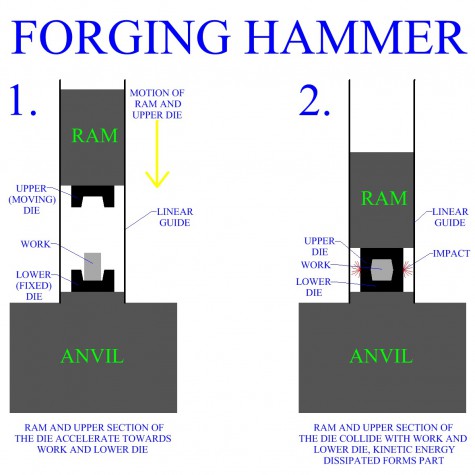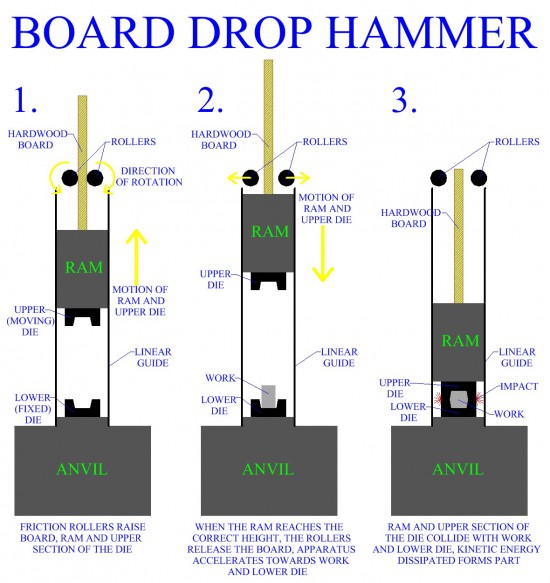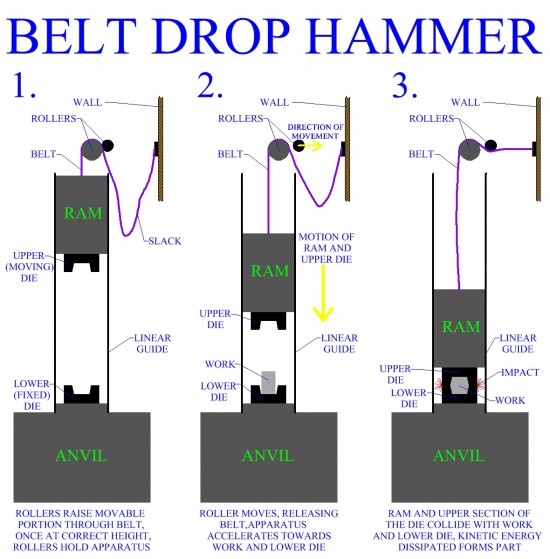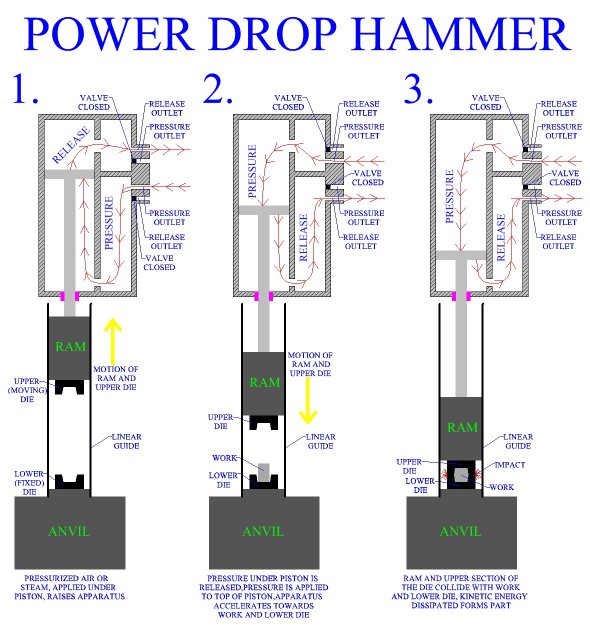FORGING
PROCESSES
Metal Forging
Hydraulic And Mechanical Presses
Heading Or Upset Forging
Metal Piercing
Metal Sizing
Roll Forging
Swaging Or Radial Forging
Metal Hobbing
Metal Ball Forging
Orbital Forging
Ring Forging
Riveting
Metal Coining
Isothermal Forging
Trimming Of Forged Parts
High Energy Rate Forging
MANUFACTURING
PROCESSES
Metal Casting
Metal Forming
Metal Rolling
Metal Extrusion
Metal Drawing
Sheet Metal
Powder Processes
Drop Forging Hammers
There are many different types of machine tools that can be used during a metal forging operation. Metal forging processes may be classified by the technique by which they deliver force/energy to the work stock. The specific machine tool used will define the type of force delivery system employed to forge the work stock. Since the method by which force is transferred from the machine tool to the work is fundamentally different between the two classes of forging processes, machines employed for metal forging generally belong in one of two major categories, drop forging hammers or machine presses. Machine tools for forging, either presses or hammers, will both deliver force to the metal work through the forging die. However, the two classes of machine tools differ in many respects.
Drop forging implies a, fast, high energy transfer of the force to forge the work. In the drop forge, this energy is transferred by mechanical means, specifically a hammer and anvil setup. The drop forging hammer can be powered by gravity alone or additional sources of force can augment the hammer's power. The second major classification of metal forging processes is press forging, similar to drop forging, press forging also transfers energy to the work stock by mechanical means. However, the force is applied more gradually, over a longer stroke. This type of process employs a pressing action.This section will discuss forging hammers, presses, (also used extensively in extrusion and sheet metal fabrication, hence the term press working), are covered next. Selection of a specific machine tool will depend on the details of the metal forging process, and the availability of machines. The size and geometry of the part to be forged, the accuracy desired, the strength of the work metal, the temperature that the work is forged, the desired mechanical properties of the final forging, the sensitivity of the work to strain rate, the amount of parts to be produced, the time to produce the part and the expense of the manufacturing operation, are all factors that go into the selection of a particular metal forging machine tool.
A forging hammer derives its power from the kinetic energy of a ram and the upper portion of the mold put into motion. The ram and upper die travel in a linear path towards the lower die and anvil. The work is placed in the lower die. At the point of collision when the two die meet, kinetic energy is transferred to the metal forging, forming the part. Although the work stock absorbs a tremendous amount of the blow, much energy is transferred to the machine and to the floor of the building. This should be a consideration when planning a manufacturing operation using a drop forging hammer.
Figure:172 
|
Often times, several blows of a drop forging hammer may be needed to completely forge a part. The process is repeated until the die close. The mass of the ram is an important factor in the operation. In manufacturing industry, rams for forging hammers typically weigh several thousand pounds, although the weight might be as low as several hundred pounds, and ram weights as high as 50,000 lbs are possible with some power forging hammers. The anvil for a forging die needs to provide a solid base for the operation, anvil weights may be as high as twenty or thirty times the weight of the hammer. The term drop forging may be used for processes employing a forging hammer. However, drop forging may imply that the force of gravity is the only force employed by the hammer to obtain its energy to forge the part. This section, while covering true drop forging machine tools, will also cover the power forging hammer which relies on not only gravity but also on additional derived force from the machine tool itself.
Board Drop Hammer
The board drop hammer is a drop forging machine tool that relies only on gravity. A hardwood board is attached to the ram, rollers grip the board and can raise the board and ram due to friction forces between the board and rollers. Once the ram is raised to the height needed, the rollers can be pulled apart and the apparatus will be released, sending the forging hammer on its way.
Figure:173 
|
Belt Drop Hammer
The belt drop hammer is another drop forging machine tool that operates similarly to the board drop hammer. Rollers grip a belt that is connected to the ram. They raise the hammer by the belt, this causes the belt to gain slack. Pulling apart the rollers will release the belt. When the belt is released, the hammer will fall. This type of machine also relies only on the force of gravity.
Figure:174 
|
Power Drop Hammer
Power drop hammers use the force of pressurized air or steam to raise the ram, and to accelerate it downward to strike the work. Power drop hammers can accelerate the ram downward to a higher speed than conventional drop forging machine tools, they can also accommodate a more massive ram. Power drop hammers can deliver much more energy per blow than conventional drop forging hammers.
This powerful machine tool relies on gravity to some extent, like the previous drop forging hammers, but the power delivery system allows for the utilization of much more force, both in raising and dropping the hammer. Pressurized air or steam is used to lift the hammer to the right height. The pressure holding up the ram is then released and simultaneously pressure is applied to the top of the apparatus. A release in pressure lets the hammer drop and a simultaneous application of pressure to its top sends it accelerating downward at a high rate of speed towards the metal forging.
Figure:175 
|